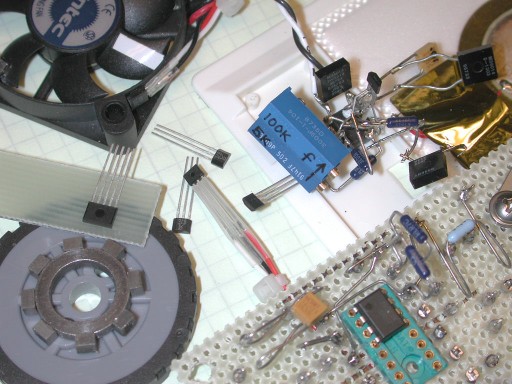|
Wednesday, October 1, 2003
Center on Contemporary
Art, Seattle, WA
Laura MacCary and Lawrence MacCary, "Dialectric":
Seattle artist and weaver Laura MacCary and her father and
collaborator, Spokane sculptor, poet and electronics expert
Lawrence MacCary, will be talking about the hows and whys
of their series of interactive artworks combining weaving
and electronics. They will also unveil a new piece for the
first time. Each piece in the series consists of an electronic
component woven of conductive or resistive materials cast
off by industry, and a circuit designed around the weaving.
By interacting with the weaving the viewer physically enters
the circuit, and the circuit passes through the viewer,
blurring the boundary between them. The title of the series,
Dialectric, is taken from the words dialectic, meaning the
juxtaposition or interaction of two conflicting ideas or
forces, and dielectric, an insulating substance or one in
which an electric field can be maintained with a minimum
loss of power. Videos of some pieces in the series can be
seen at http://www.maccary.com/.
Toby Paddock, "Magnetic Sensors For The Unwashed
And Lazy: using Hall Effect devices without learning very
much": Seattle-based Toby Paddock gives an introduction
to simple sensors and switches that detect the position
of a magnet. Inside is a lot of science, but from the outside,
they are small, cheap, rugged, have few wires, and are pretty
easy to get along with. They may be a reasonable alternative
to mechanical switches and potentiometers in some things
that move. They can be simpler to use than you might realize.
http://www.seanet.com/~tpaddock/
will tell you more about Toby's passions and interests.


Pinky & Rex, Talk Title TBD: Seattle-based
experimental musicians Pinky & Rex re-contextualize thrift-store
toys, toy instruments and other electronic oddities, appropriating
rather than reinventing the devices to create symphonic
walls of sound using “crappy Casios”, discarded metal objects,
toy tambourines, walkie-talkies and so forth. While they
do some basic circuit bending and are working on some custom
amplification setups using old stereos, discarded speakers
and megaphones, their main aim is to see what kind of sound
they can coax out of interesting stock components by working
instinctively rather than tweaking those components into
something else altogether. See and hear the results at this
month's dorkbotsea meeting!
|
After-speaker performance
|
Pinky & Rex will be performing after the meeting
on their collected oddities.
Join us for beer, music, conversation and mingling
after the speakers have spoken - and bring work-in-progress
for peer review and comment during this last part of the
evening if you like: we'd love to see what you've been working
on!
Toby Paddock: Toby Paddock is "just some guy that
thinks hall effect sensors are kind of neat and that everyone
should know about them". He also likes to listen to audio
frequency magnetic fields using homemade pickup coils, but
that's a different thing altogether. Tinkers with sound,
electronics, and field recording, but mostly speculates
about projects that never get started. Is trying to develop
the "Shut Up And Solder" method of actually getting something
built. He works for an aerospace electronics company in
the environmental test labs and lives in Everett, WA with
his wife, 2 kids, 1 fish, 2 cats, 1 dog, and a hamster.
They appreciate his enthusiasm for his hobbies, however,
not sharing his unique admiration of sound often send him
to the garage.
Laura MacCary and Lawrence MacCary: Laura MacCary
is a weaver who has also been studying electronics for the
last few years.Her father, Lawrence MacCary, is a sculptor
and a longtime electronics experimenter, whose interests
span a wide spectrum of electrical and electronic subjects.
His projects are mostly electro-mechanical, some electro-magnetic,
and others are both solid-state and "hollow-state" based
adventures. Laura is interested in the idea of weaving as
a ubiquitous but little-noticed technology, unvalued while
still essential to human survival. Electronics is another
technology that is becoming so omnipresent and so integrated
with our lives that we will soon cease to notice it. However,
electronics is sure to cross the boundary of our skin, and
enter our bodies. Its fields already do. It is this intimate
interface between people and technology that Laura examines
in this series of works. Each piece in the series consists
of an electronic component woven of conductive or resistive
materials cast-off by industry, and a circuit designed around
it. By interacting with the weaving the viewer physically
enters the circuit, and the circuit passes through the viewer,
blurring the boundary between them. The title of the series,
Dialectric, is taken from the words dialectic, meaning the
juxtaposition or interaction of two conflicting ideas or
forces, and dielectric, an insulating substance or one in
which an electric field can be maintained with a minimum
loss of power. Laura sees these as metaphors for the participants
in an interaction, and the space between them. This series
is also an opportunity to collaborate with her father, and
she see the works as metaphors for aspects of our relationship,
and relationships in general.
|